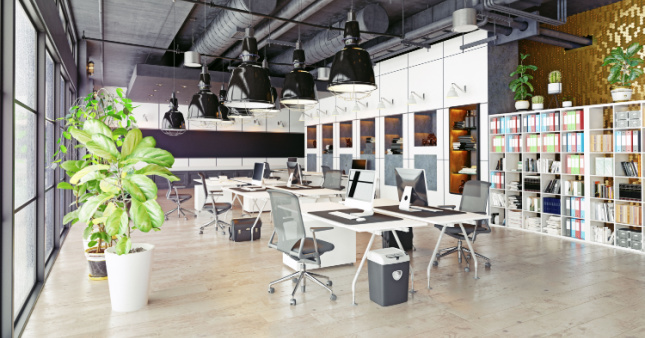
The best workplace designs aren’t just easy on the eye, they’re also carefully planned to provide the perfect conditions for everybody’s health and safety.
Workplace design may not be the first thing that comes to mind when you think about health and safety, but it can play a pivotal role in the well-being of the people using it. From lighting and temperature to noise levels and ergonomics, there are many factors to consider.
So, if you’re looking to boost morale and productivity, while also reducing the risk of injury, it’s time to optimise your workplace design. Let’s explore how you can do exactly that.
Essential design considerations
Whether your workplace is a factory with chemicals and heavy machinery, or an office with desks and chairs, every environment involves risks and hazards. Your design choices have the capacity to either remove risks completely, or dramatically reduce the chances of them being realised, so it’s important to make them carefully.
Here are some of the most important elements to consider when designing a workspace optimised for health and safety:
Lighting
Proper lighting is essential for good visibility and preventing accidents or eye strain. Employees should be able to see clearly to perform their work tasks safely. Beyond electric light fittings, you can use glass partitions instead of walls to allow natural light to flow through your workspace. When it comes to employee mental health, there’s a direct relationship between well-being and sunlight.
Ventilation
Good ventilation helps to remove pollutants and contaminants from the air, which can improve respiratory health and reduce the risk of headaches, dizziness, and fatigue. For those with a bigger budget, air purifiers can help prevent the spread of airborne diseases, neutralise chemical pollutants, and ease the symptoms of asthma.
Noise levels
Excessive noise levels can lead to hearing loss, stress, and fatigue. Workplaces should be designed to minimise noise levels as much as possible. If an area of your workplace is especially noisy, consider soundproofing it for the benefit of workers in other parts of the building.
Temperature and humidity
The temperature and humidity of the workplace should be comfortable for employees. Extreme temperatures can lead to heat stress or cold stress, which can increase the risk of accidents and injuries.
Slips trips and falls
Using cable covers for all electrical equipment, including PCs and laptops, can reduce the likelihood of slips and trips, as can using anti-slip flooring in high-traffic areas like entrances, hallways and stairwells.
Safe layouts
Spatially, your workplace should be laid out in a way that minimises the risk of accidents and injuries. For example, aisles should be wide enough for employees to walk in safely without overcrowding.
Ergonomics
The design of furniture and equipment should be ergonomic, which means that it is designed to fit the human body. This can help to prevent musculoskeletal injuries, such as back pain and carpal tunnel syndrome.
Modular furniture
Using modular furniture, like stackable chairs, enables you to quickly customise your environment while still maintaining a safe layout.
Fire safety
Your workplace should be designed to minimise the risk of fire and to provide a safe escape route in case of a fire. Ensure signage clearly indicates fire exit routes and place fire extinguishers in high-risk areas (plant rooms, kitchens and IT suites).
Clear signage
Having the right signage can alert people to the dangers around them. Your workplace’s hazards will determine the signs you need, maybe giving warning about heavy machinery or hazardous substances. Signage can also prompt staff to wear protective clothing or ward them off dangerous activities.
Bathroom sanitation
A combination of motion activated taps, infrared toilet flushing, contactless towel dispensers and air hand dryers can help reduce the spread of bacteria. Workplace bathrooms tend to be a health and safety hotspot, so be sure to design yours with proper care and attention.
Security
Finally, your workplace should be designed to be secure, with access restricted to authorised personnel. This can help to prevent theft, vandalism, and other crimes.
Design for Safety
Design for Safety (DFS) is a risk management approach that integrates control measures into the design process. The aim is to eliminate, or at least minimise, any risks that the finalised design entails.
In the context of workplace design, DFS involves considering risks as early as possible when planning a new or modified work environment (rather than addressing them retroactively).
DFS also encourages involving all stakeholders in the design process, including employees, customers, and regulators. This input will help you plan an environment that caters for everyone’s needs, including people of all ages and sizes, as well as those with disabilities. Remember – the people who use a workplace every day have an in-depth understanding of its hazards.
Finally, it’s important to keep your workplace clean and well-maintained. You should also continue to monitor it for new or unaddressed hazards and make improvements as needed.
There you have it – a safe work environment by design. If you follow as many of these tips as possible, you’ll be well on your way to creating a healthy workplace that benefits everybody using it.
How can Employsure help?
As a business owner, you have a legal responsibility towards workplace health and safety. With constantly changing legislation and regulations, it can be tricky for you to keep up with your duties.
Over 30,000 businesses across Australia and New Zealand have trusted us to support them. Our 24/7 Advice Line is available free of cost for all business owners. Call us today on 0800 521 592 to get all your difficult health and safety questions answered.
